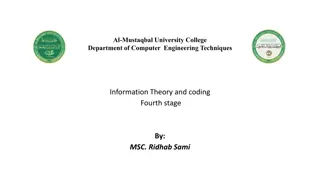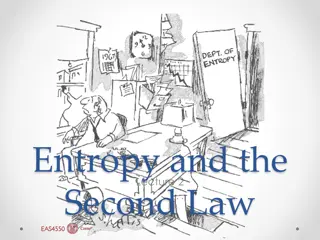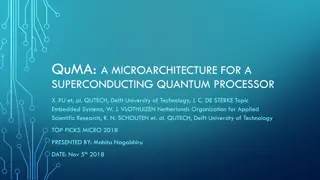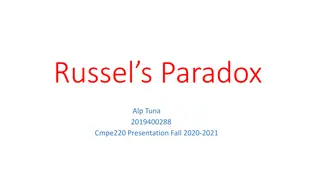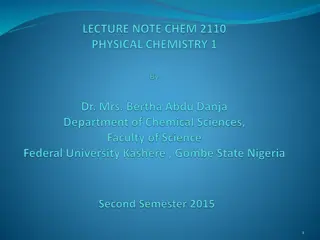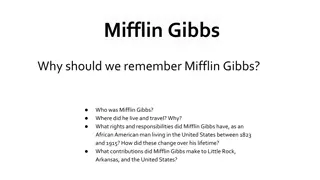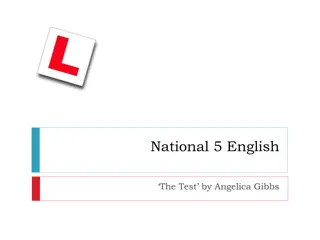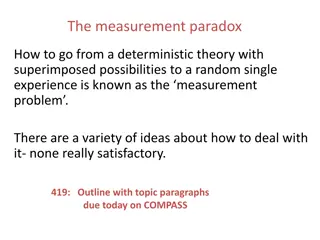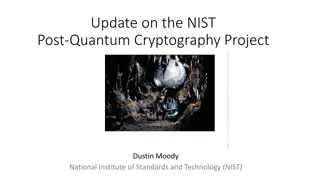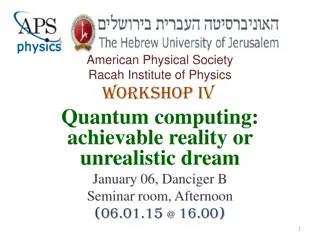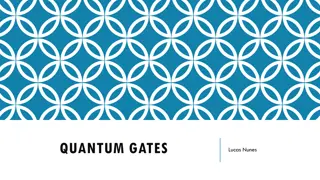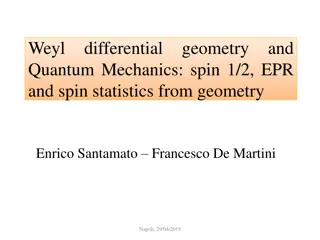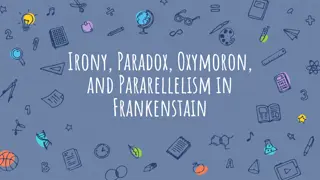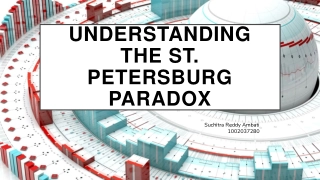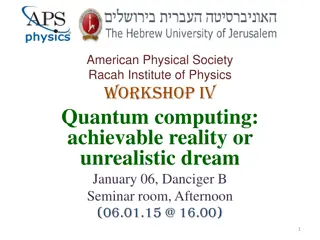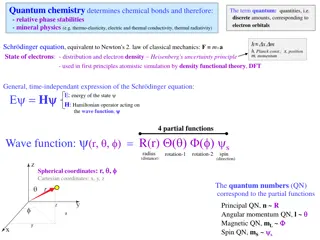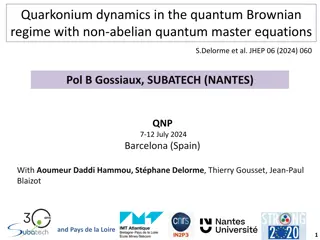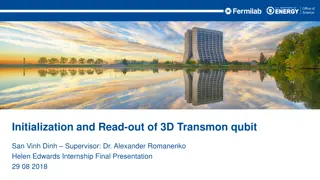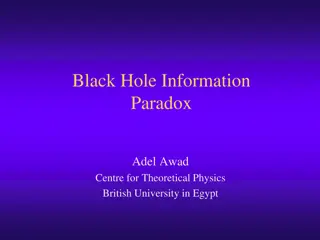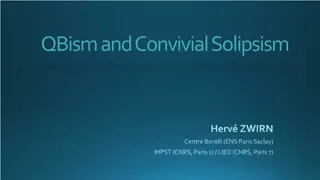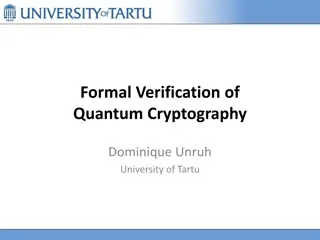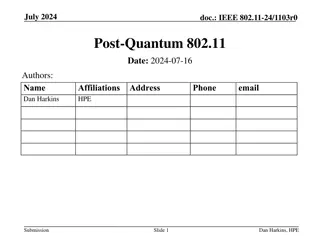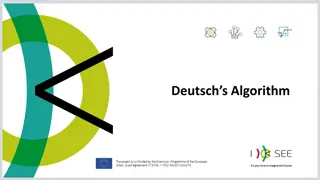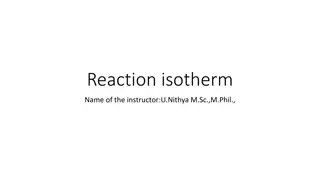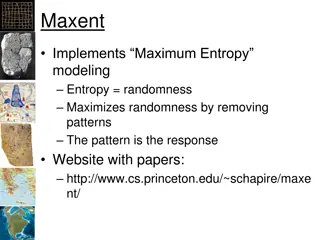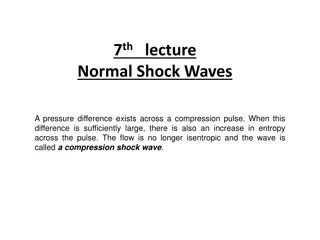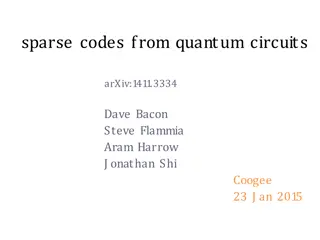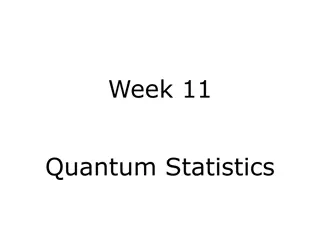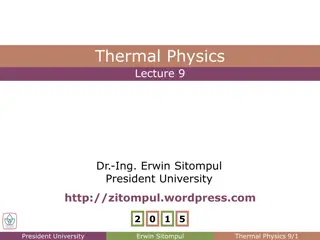Gibbs Paradox and Quantum Information: Understanding Entropy and Resolution
Description of the Gibbs problem of entropy mixing gases, conventional resolution, issues of (dis)continuity, the role of indistinguishability and quantum mechanics in resolution, dissenting views, necessity of quantum mechanics, and the relationship between statistical mechanics and entropy. Key discussions revolve around the Gibbs Paradox, irreversibility, and the unresolved aspects of entropy in thermodynamics and statistical mechanics.
Download Presentation

Please find below an Image/Link to download the presentation.
The content on the website is provided AS IS for your information and personal use only. It may not be sold, licensed, or shared on other websites without obtaining consent from the author. Download presentation by click this link. If you encounter any issues during the download, it is possible that the publisher has removed the file from their server.
E N D
Presentation Transcript
Gibbs Paradox and Quantum Information Unnikrishnan. C. S. Gravitation Group & Fundamental Interactions Lab Tata Institute of Fundamental Research Homi Bhabha Road, Mumbai 400005 IPQI Gibbs paradox and Information
Plan of the talk: 1) Description of the Gibbs problem of entropy of mixing of gases 2) Description of the conventional resolution 3) The problem of (dis)continuity 4) Discussion of the ingredients of resolution Indistinguishability and QM 5) Discussion of dissenting views 6) Is QM necessary? If so, quantum information will be decisive. 7) What exactly is indistinguishability for statistical mechanics and entropy? 8) Summary of my (integrating) views IPQI Gibbs paradox and Information
Entropy: Information theory = Thermodynamics Statistical mechanics dQ T B = ln S p p = ln S k W S i i B A i In a random experiment with W outcomes, p=1/W Average over several such partitions with prob. pi ? Landauer, Jaynes, Bennett Irreversibility as a crucial issue. Completely reversible computation (Toffoli etc.) IPQI Gibbs paradox and Information
E. T. Jaynes, The Gibbs Paradox, In Max. entropy and Bayesian methods (1992) Some important facts about thermodynamics have not been understood by others to this day, nearly as well as Gibbs understood them over 100 years ago... But recognizing this should increase rather than decrease our confidence in the future of the second law, because it means that if an experimenter ever sees an apparent violation, then instead of issuing a sensational announcement, it will b e more prudent to search for that unobserved degree of freedom. That is, the connection of entropy with information works both ways; seeing an apparent decrease of entropy signifies ignorance of what were the relevant macrovariables. the whole question of in what way or indeed, whether classical mechanics failed in comparison with quantum mechanics in the matter of entropy, now seems to be reopened. Recognizing this, it is not surprising that entropy has been a matter of unceasing confusion and controversy from the day Clausius discovered it. Different people, looking at different aspects of it, continue to see different things because there is still unfinished business in the fundamental definition of entropy, in both the phenomenological and statistical theories. further theoretical work will b e needed before we can claim to understand entropy. IPQI Gibbs paradox and Information
You should call it entropy, for two reasons. In the first place, your uncertainty function has been used in statistical mechanics under that name, so it already has that name. In the second place, and more important, no one knows what entropy really is, so in a debate you will always have the advantage . C. Shannon to M. Tribus (1961). J. von Neumann, IPQI Gibbs paradox and Information
= + Entropy ln S k V C V V/2 V/2 ( V ) = Entropy ln S Nk V = = Entropy 2( / 2) ln k / 2 ln ln2 S N Nk V Nk = = S ln2 S S Nk f i V/2 V/2 V = Entropy of mixing ln2 S Nk IPQI Gibbs paradox and Information
Requirements and problems: a) Change in entropy should be zero for mixing of the same gas b) It should be NkB ln2 for two different species of gases c) The change in entropy does not seem to depend on the magnitude of sameness d) Hence, the change is discontinuous on the parameter sameness Core issue: How was the expression for entropy derived? = ln S k W B IPQI Gibbs paradox and Information
So called classical counting: n i ! N g n k n n ! n n ... n N g g g i k 1 2 = = 1 2 Number of microstates i W ! !... ! ! n 1 2 k i i ( ) + + ln ln ln ln W N N N n g n n n i i i i i i g n = + ln ln i N N n i i i exp( exp( i / ) exp( / ) Ng kT kT Ng kT = = i i i i n i / ) g Z i i = + ln ln / W N Z U kT g n Z N = / kT ln ln i n n e 3 2 i i i + + ln ln N V T C i / ! W W N The Gibbs indistinguishability correction: V N = + + ln ln ln ln W N Z N N N N C Problem of entropy of mixing solved, but provoked century+ old discussions IPQI Gibbs paradox and Information
Problem of entropy of mixing solved, but provoked century+ old discussions 1) How does one decide when to divide by N! Is entropy a matter of subjective abilities on distinguishability? 2) How does nature decides when to increase entropy and when not? 3) What is an operational and reliable definition of indistinguishability? 4) Why are classical particles distinguishable? Are they really? Or do we need quantum mechanics to justify indistinguishability of identical particles? IPQI Gibbs paradox and Information
Quantum mechanics and Indistinguishability D1 S1 S2 S2 D2 S1 or r r Interference V V/2 V/2 IPQI Gibbs paradox and Information
Another counting exercise: n2 n1 + n i n i ( 1)! 1 ! ! ! n n g g g g n g g n i i = = = Number of microstates i i i W W ( ) ! ! ! i i i i i i i i i i n i ! N g n k n n ! n n ... n N g g g i k 1 2 = = 1 2 i W Compare with ! !... ! ! n 1 2 k i i IPQI Gibbs paradox and Information
Classical identicalness and indistinguishability Conventionally considered distinguishable through Newtonian histories But statistical physics shouldn t care since nature does not! Nor does classical information theory. V V/2 V/2 IPQI Gibbs paradox and Information
Language and representation of Information INFORMATION 1000101110000 Indistinguishability of permutations 1) Indistinguishable material entities as holders of information (bits) 2) Their Physical states as Information Change in physical state is change in information IPQI Gibbs paradox and Information
Criterion for distinguishability V V/2 V/2 V/2 V/2 V Distinguishability = Physical separability, in principle. If the system is differentially sensitive to external force fields (interactions), it is separable and distinguishable (for example, the tiniest of charge on one species and nothing on other). However, slightly different charges on both should translate to some indistinguishability. That is where a more precise formulation in term of QM states comes in. Full distinguishability is equivalent to orthogonality of states. IPQI Gibbs paradox and Information
Entropy of Unmixing: V/2 V/2 V Requires a physical process involving external forces, or a filter operating on the physical difference. Energy has to be pumped into the system, because un-mixing cannot happen spontaneously. | QM The efficiency of un-mixing depends on 1 2 IPQI Gibbs paradox and Information
Entropy: Information theory = Thermodynamics Statistical mechanics dQ T B = ln S p p = ln S k W S i i B A i In a random experiment with W outcomes, p=1/W Average over several such partitions with prob. pi ? Landauer, Jaynes, Bennett Irreversibility as a crucial issue. Completely reversible computation (Toffoli etc.) IPQI Gibbs paradox and Information
Entropy of parts and the whole: Two-particle maximally entangled state and its (unmeasured) single particle parts The single particle parts are not prepared as a mixture, and yet they are entropically. different in their local partitions. There is no Extesnsivity. IPQI Gibbs paradox and Information
Conclusions: 1) A resolution of the Gibbs paradox requires a clear understanding of the notion of indistinguishability, but this is not specific to QM hence QM is not an essential ingredient for its resolution. 2) However, QM notion of states and orthogonality is needed to define a measure for sameness, or indistinguishability. Once this is done, the problem of discontinuity disappears. 3) Classical information theory is sufficient to formulate and resolve the issue unambiguously, but quantitative continuous description requires the QM notion of states. However, there is really no classical world! In that sense, QM is essential to resolve ANY physical problem, including the Gibbs paradox and the related issues of Maxwell s demon etc. IPQI Gibbs paradox and Information


